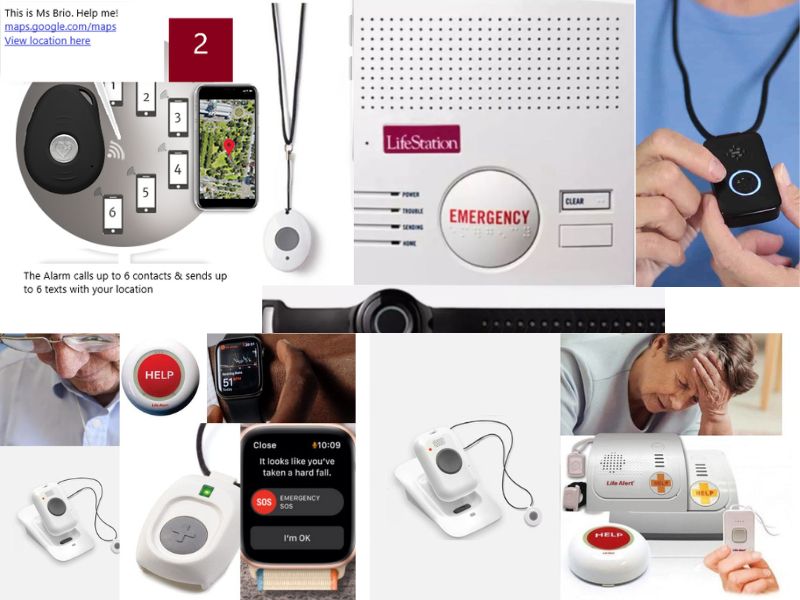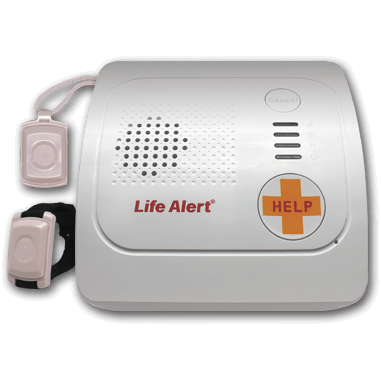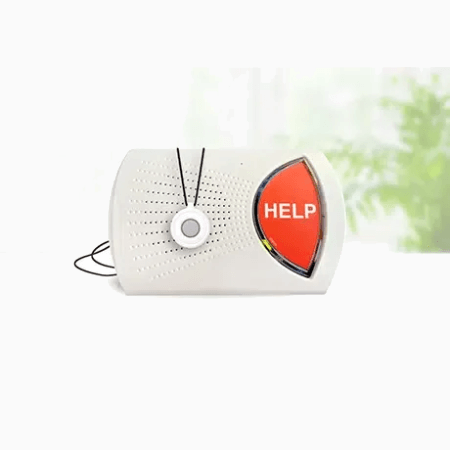Life Alert vs Medical Alert
In the realm of personal emergency response systems, two brands stand out: Life Alert and Medical Alert. These companies provide systems designed to signal the presence of a hazard requiring urgent attention and to summon emergency medical personnel.


4.7
Starts at $49 per month
Life Alert


4.8
Ranges from $20 to $50
Medical Alert
Brio House is an independent review site. We may earn money when you click links inside our site.
In the realm of personal emergency response systems, two brands stand out: Life Alert and Medical Alert. These companies provide systems designed to signal the presence of a hazard requiring urgent attention and to summon emergency medical personnel.
Life Alert is a medical alert system specifically designed to protect seniors in a health emergency. Life Alert services can help seniors remain independent and possibly avoid a retirement home by sending help fast in the event of a medical, fall, shower, and home emergencies. As the creator of the, “Help, I’ve fallen and I can’t get up!” medical alert company, Life Alert’s medical alert system provides emergency help 24/7 even if you can’t reach a phone.
On the other hand, Medical Alert is a brand that offers medical alert systems with push buttons starting at $19.95. They provide peace of mind with home & mobile systems or fall detection. With 24/7/365 help available at the press of a button, you’ll have peace of mind with their easy-to-use medical alert systems. They offer no hidden fees or long-term contracts, and you only pay for your monthly monitoring service.
These systems, often referred to as personal emergency response systems, medical emergency response systems, and fall monitors, are designed to provide quick assistance in times of medical emergencies, such as falls, heart attacks, or home intrusions. They are especially useful for the elderly, people with disabilities, and those who live alone.
The monitoring center plays a crucial role in these systems. When the help button on the system is pressed, the monitoring center is alerted, and trained professionals communicate with the user to understand the situation and provide the necessary assistance. This could involve contacting family, neighbors, or emergency medical services.
Both Life Alert and Medical Alert offer a variety of systems to suit different lifestyles and needs. These include home-based systems, mobile medical alert systems, and systems with automatic fall detection. The specific features and services offered by each company will be discussed in more detail in the following sections.
It’s important to note that while these systems can provide a valuable safety net, they are not a substitute for medical care or regular check-ups with a healthcare provider. Always consult with a healthcare provider for professional medical advice.

The Importance of Life Alert and Medical Alert Systems
The primary purpose of Life Alert and Medical Alert systems is to provide immediate assistance in the event of a medical emergency. This is particularly crucial for seniors, people with disabilities, or those with serious health conditions who live alone. The peace of mind these systems offer is invaluable, not only to the users themselves but also to their family members and caregivers.
One of the key features of these systems is the ability to summon help at the push of a button. This is especially important in situations where the user is unable to reach a phone, such as after a fall or during a serious health event like a stroke or heart attack. According to the Centers for Disease Control and Prevention, falls are the leading cause of injury and death in older Americans, making the fall detection capabilities of these systems particularly valuable.
However, it’s important to note that Life Alert does not currently offer automatic fall detection as a feature in their devices. Instead, the user must press the button on their device to alert the monitoring center in the event of a fall. While this might seem like a limitation, it’s worth noting that no fall detection system is 100% accurate, and false alarms can occur with systems that automatically detect falls. Therefore, a manual alert system can sometimes be more reliable, as it ensures that the alert is not triggered by an accidental drop or sudden movement.
On the other hand, Medical Alert offers automatic fall detection as an optional feature in their devices. This feature works by using sensors in the device to detect sudden movements or impacts that are characteristic of a fall. If a fall is detected, the device automatically sends an alert to the monitoring center, even if the user is unable to press the button.
Moreover, these systems can also provide assistance in non-medical emergencies. For example, if a user feels threatened by a potential intruder, they can press the help button to connect with the monitoring center, which can then alert the appropriate authorities.
In addition to providing immediate assistance, Life Alert and Medical Alert systems can also contribute to the user’s overall health and well-being. For instance, some systems offer wellness checks and medication reminders, which can help users manage their health more effectively.
Life Alert and Medical Alert systems provide a critical service that can save lives and provide peace of mind for users and their loved ones. The specific features and services offered by each company will be discussed in more detail in the following sections.
Life Alert and Medical alert: An Overview


How Life Alert and Medical Alert Systems Work
Life Alert and Medical Alert systems are designed to be simple and easy to use, even in stressful situations. Here’s a basic overview of how they work:
- Activation: The user presses the help button on their medical alert device when they need assistance. This button can be worn as a pendant around the neck, on the wrist, or even attached to clothing. Some systems also offer fall detection devices that automatically send an alert if a fall is detected.
- Communication: Once the button is pressed, the device communicates with the base unit, which then connects to the monitoring center. The base unit works similarly to a speakerphone, allowing the user to communicate with the monitoring center operator directly.
- Assessment: The operator at the monitoring center talks to the user to understand the situation. If the user can’t speak or doesn’t respond, the operator will follow a pre-determined protocol, which may involve contacting emergency services immediately.
- Assistance: Depending on the situation, the operator may call a family member, neighbor, or emergency services. The goal is to ensure that the user receives the appropriate assistance as quickly as possible.
- Follow-up: After the situation has been resolved, the monitoring center will typically follow up with the user to ensure they are safe and well.
Life Alert and Medical Alert systems provide a critical service that can save lives and provide peace of mind for users and their loved ones. The specific features and services offered by each company will be discussed in more detail in the following sections.
Detailed Analysis of Life Alert

Features and Services
- Life Alert provides a range of services aimed at ensuring the safety and well-being of its users. The company’s offerings include protection for medical emergencies, shower emergencies, and personal protection. They also offer a mobile medical alert system called “Help on the Go + GPS” for users who are often out and about.
- The emergency pendant provided by Life Alert is fully waterproof and has a range of 800 feet. It can be worn as a pendant or a wristband. One of the standout features is that the batteries never need charging, lasting up to 10 years.
- The Life Alert base station, also known as the signature main unit, can be connected via cellular or landline. It comes with a backup battery and offers 24/7 US-based monitoring. All the equipment provided by Life Alert is maintenance-free.
Pricing of Life Alert
The pricing details of Life Alert are not publicly available on their website. Potential customers are encouraged to call for pricing information.
Contract Terms of Life Alert
Life Alert does not disclose the specifics of their contract terms on their website. However, it’s known that they offer various protection packages that can be specifically designed for individual lifestyles, including wireless options.
Customer Reviews of Life Alert
Life Alert has numerous testimonials on their website, many of which praise the quick response time and the life-saving nature of the service. Users have reported that the service has been instrumental in getting them the help they needed during emergencies, particularly when they were home alone and unable to reach a phone.
Detailed Analysis of Medical Alert

Medical Alert, like Life Alert, is a brand that provides medical alert systems to help ensure the safety and well-being of its users, particularly the elderly and those with certain medical conditions. Here’s a more detailed look at what Medical Alert offers:
Features of Medical Alert
- Medical Alert offers both at-home and on-the-go systems.
- The at-home systems are designed for individuals who spend most of their time at home.
- The on-the-go systems are for those who are active and often out and about.
- The at-home systems come with a base unit and a wearable help button, which can be worn as a necklace or bracelet.
- The base unit is equipped with a two-way speaker, allowing users to communicate directly with the monitoring center in case of emergencies.
- The on-the-go systems are portable devices that can be carried around.
- They come with GPS tracking, allowing the monitoring center to locate the user in case of emergencies.
- Some models also come with fall detection capabilities.
- Both types of systems are monitored 24/7 by trained personnel who can provide immediate assistance and call 911 if necessary.
Pricing of Medical Alert
- The pricing for Medical Alert systems varies depending on the type of system and the features included.
- The monthly fee for at-home systems starts at around $20 to $30.
- On-the-go systems, which offer more features and flexibility, are generally more expensive, with monthly fees ranging from $29 to $45.
- It’s important to note that these are the basic service fees and do not include additional features or services.
- Some features, such as automatic fall detection, are considered add-ons and come with an additional cost.
Contract Terms of Medical Alert
- Medical Alert, like most medical alert companies, charges a monthly fee for their service.
- This fee covers the cost of running a fully staffed monitoring center that provides round-the-clock assistance.
- While the specifics of the contract terms may vary, it’s common for medical alert companies to offer different payment plans, such as monthly, quarterly, or annually.
- Some companies may offer discounts for longer-term contracts.
Customer Reviews of Medical Alert
- Customer reviews of Medical Alert are generally positive, with many users praising the system’s reliability and the company’s responsive customer service.
- Users have also noted the ease of use of both the at-home and on-the-go systems, making them a popular choice among older adults.
- However, as with any product, there are also some negative reviews.
- Some users have reported issues with the battery life of the devices, while others have expressed dissatisfaction with the additional fees for certain features and services.
Medical Alert is a reputable brand in the medical alert industry that offers a range of systems to suit different needs and lifestyles. Whether you’re looking for a basic at-home system or a more advanced on-the-go system, Medical Alert has options to consider. As always, it’s important to do your research and consider your specific needs before making a decision.
comparing Life Alert vs Medical ALERT
| Company | Device Variety | Fall Detection | 24/7 Monitoring | Long Battery Life | Pricing | Customer Reviews |
|---|---|---|---|---|---|---|
 |
View Packages | No | Yes | Yes | Starts at $49/month | Quick response time |
 |
View Packages | Yes | Yes | Yes | Ranges from $20 to $50 | Ease of use |
The Role of Monitoring Centers in Life Alert and Medical Alert Systems
Monitoring centers are the heart of any medical alert system. They are the first point of contact when an emergency medical alert button is pressed. Here’s how they play a crucial role:
- 24/7 Availability: Monitoring centers are staffed round the clock, ensuring that help is available whenever it’s needed. This is especially important for older adults who might need assistance at any time of the day or night.
- Trained Professionals: The emergency operators at these centers are trained to handle the needed assistance. They can provide immediate assistance and guide the user until help arrives.
- Quick Response: In an emergency, every second counts. Monitoring centers are equipped to respond quickly, often within seconds, to calls for help.
- Communication with Emergency Services: The monitoring center is responsible for contacting the appropriate emergency services, be it medical, fire, or police, based on the situation.
- Support for Family Members: In addition to contacting emergency services, the monitoring center can also inform designated family members or caregivers about the situation.
Fall Detection Capabilities of Life Alert and Medical Alert Systems
Fall detection is a crucial feature in medical alert systems. It provides an additional layer of safety, especially for seniors who are at a higher risk of falls. Both Life Alert and Medical Alert offer fall detection capabilities, but they implement this feature in slightly different ways.
Life Alert
Life Alert, one of the most recognized brands in the industry, offers a range of devices designed to provide immediate help in the event of a medical emergency, including falls. However, it’s important to note that Life Alert does not currently offer automatic fall detection as a feature in their devices. Instead, the user must press the button on their device to alert the monitoring center in the event of a fall.
While this might seem like a limitation, it’s worth noting that no fall detection system is 100% accurate, and false alarms can occur with systems that automatically detect falls. Therefore, a manual alert system can sometimes be more reliable, as it ensures that the alert is not triggered by an accidental drop or sudden movement.
Medical Alert
On the other hand, Medical Alert, another leading brand in the industry, offers automatic fall detection as an optional feature in their devices. This feature works by using sensors in the device to detect sudden movements or impacts that are characteristic of a fall. If a fall is detected, the device automatically sends an alert to the monitoring center, even if the user is unable to press the button.
Medical Alert’s fall detection feature is compatible with both their home and on-the-go systems, providing comprehensive coverage whether the user is at home or out and about. However, it’s important to note that this feature comes with an additional monthly cost.
Both Life Alert and Medical Alert offer solutions for fall detection, but they approach this feature in different ways. Life Alert relies on manual alerts triggered by the user, while Medical Alert offers automatic fall detection as an optional feature. The choice between these two systems will depend on the user’s specific needs, lifestyle, and budget.
The Importance of Battery Life in Life Alert and Medical Alert Systems
Battery life is a critical factor when choosing a medical alert system or Life Alert. Here’s why:
- Reliability: A device with a long battery life ensures that the system is always ready to work when it’s needed the most.
- Convenience: Devices with longer battery life require less frequent charging or battery changes, making them more convenient for the user.
- Peace of Mind: Knowing that the device has enough battery life gives users and their families peace of mind.
The Role of the Better Business Bureau in Rating Life Alert and Medical Alert Companies
The Better Business Bureau (BBB) is a non-profit organization that provides information about the trustworthiness of businesses. Here’s how it helps in rating Life Alert and Medical Alert device companies:
- Business Evaluation: The BBB evaluates businesses based on various factors like transparency, honesty in advertising, and customer complaints.
- Rating System: The BBB provides a rating from A+ (highest) to F (lowest) for businesses. This rating can help potential customers make informed decisions.
- Customer Reviews and Complaints: The BBB also provides a platform for customers to leave reviews and file complaints about businesses. This can give potential customers a better idea of what to expect from a company.
Unfortunately, due to technical issues, we were unable to retrieve the BBB ratings and customer reviews for Life Alert and Medical Alert at this time.
Tips for Saving Money on the Best Medical Alert Systems
While medical alert systems are crucial for safety, they can sometimes be expensive. Here are some tips to save money on the best medical alert system:
- Compare Different Providers: Prices can vary significantly between different medical alert companies. Make sure to compare prices and features before making a decision.
- Check for Discounts: Some companies offer discounts for veterans, or AARP members. It’s always worth asking about any available discounts.
- Avoid Unnecessary Features: While features like GPS tracking and fall detection can be useful, they can also add to the cost. Consider your specific needs and avoid paying for features you don’t need.
- Consider Your Contract: Some companies, unlike Life Alert, offer month-to-month contracts instead of long-term contracts. This can save you money if you no longer need the service.
- Buy Instead of Rent: Some companies offer the option to buy the equipment outright instead of renting it. This could save you money in the long run.
Remember, while saving money is important, it shouldn’t come at the expense of your safety or peace of mind. Always choose a system that meets your needs and provides reliable service.
Conclusion: Final Thoughts on Life Alert vs Medical Alert Systems
Choosing between Life Alert and Medical Alert systems ultimately depends on your specific needs and circumstances. Both offer valuable services to the medical alert industry designed to provide peace of mind and immediate assistance in the event of an emergency.
Life Alert is a well-known brand with a range of services, including fall detection and on-the-go protection. However, the lack of transparent pricing and contract terms on their website may be a drawback for some.
On the other hand, Medical Alert offers a variety of systems to suit different lifestyles, with transparent pricing and no long-term contracts. They also offer a 30-day risk-free trial, which can be a significant advantage.
In conclusion, when choosing a medical alert system, it’s essential to consider the features, pricing, contract terms, and customer reviews. Always choose a system that offers reliable service and meets your specific needs. Remember, the goal is to ensure safety and peace of mind for the user and their loved ones.
FAQs on Life Alert and Medical Alert Systems
While we were unable to access specific FAQs from the Life Alert and Medical Alert websites, we can address some common questions based on the information available and general knowledge about these systems.
What is the range of the devices?
The range of a medical alert device can vary depending on the specific system and the layout of the user’s home. However, most medical alert systems, including both Life Alert and Medical Alert, offer a range that can accommodate most typical home layouts.
For Life Alert, the range of their devices can reach up to 800 feet. This allows users to move freely around their home and yard while still being within range of the base unit. This range ensures that users can press their help button and get the assistance they need no matter where they are in their home.
On the other hand, Medical Alert systems also offer a substantial range for their devices. For their at-home systems, the help button has an 800-foot range from the base unit. This gives users the freedom to move around their home and immediate outdoor area while still being able to call for help if needed.
For their on-the-go systems, Medical Alert uses GPS tracking to locate the user. This means that as long as the user is within a location with sufficient GPS signal, they can be located by the monitoring center in case of an emergency. This feature makes the systems ideal for users who lead active lifestyles and are often out and about.
Do the systems work outside the home?
Yes, both Life Alert and Medical Alert offer mobile medical alert systems that work outside the home. These systems are designed for active users who often leave their homes. They often include GPS tracking to help locate the user in an emergency, ensuring that help can be dispatched to the right location.
What happens if I press the button but can’t speak?
In the event that the monitoring center receives an alert but can’t communicate with the user, they will typically dispatch emergency services to the user’s location. This protocol ensures that users receive help as quickly as possible, even if they’re unable to speak or respond.
Can the systems detect falls automatically?
Medical Alert offers automatic fall detection as an optional feature. This feature can automatically alert the monitoring center if a fall is detected, even if the user is unable to press the button. However, Life Alert does not currently offer automatic fall detection. Instead, users must press the button on their device to alert the monitoring center in the event of a fall.
Do I need a landline for these systems to work?
While some systems can work with landline medical alert systems, many also offer cellular systems for homes without a landline. Both Life Alert and Medical Alert offer options for users without a landline, ensuring that users can access their services regardless of their home setup.
What is the battery life of the devices?
The battery life can vary depending on the specific device and usage. However, many devices offer a long battery life to ensure that users are always protected. For example, Life Alert has batteries that can last up to 10 years, while Medical Alert’s mobile system has a battery life of up to 5 days. It’s always important to regularly check and maintain the device’s battery to ensure it’s functioning properly.
